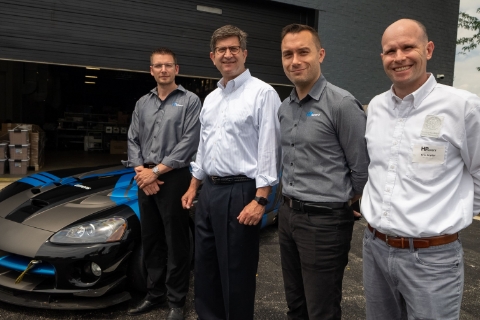SEMA News - January 2011
Lawmaker With Industry Perspective Considers Auto Powertrain Issues
By Rep. John Campbell (R-CA)
|
|
|||
An electric motor has advantages over the internal-combustion engines in cars today. They are smaller, lighter and very fast; do not need a transmission; and do not get hot nor need external cooling. Despite billions in research over the last 20 years and an enormous potential market, no breakthroughs in battery technology have occurred. The same three types of battery technologies that existed in the ’80s are what we have today, and they are only marginally cheaper and marginally higher performing.
The next best thing is to produce some of that electric power on board. The “environmentally cleanest” way to do that is with a hydrogen-powered fuel cell on board. But this technology has problems as well. For example, it is expensive in a mobile application. The most practical fuel-cell cars will probably produce hydrogen from gasoline or natural gas, although then some emissions will occur. No car manufacturer is planning a production fuel-cell car, although most have multi-million-dollar prototypes.
The most practical way to produce electricity on board is to have a gasoline-powered generator in the vehicle (plug-in hybrid). To keep the cost down, a plug-in hybrid has only enough heavy, expensive batteries to power it for a few miles until the generator kicks in. Since the internal-combustion engine is just a generator, it can operate at a constant rpm and be made considerably more efficient than if it were driving the wheels.
What about alternative fuels? There are a lot of alternatives out there, but each has challenges or else they would be in wide distribution already. The most commonly known is E85, which is a blend of 85% ethanol with 15% gasoline. Virtually all gasoline in the United States now contains 10% ethanol. We may be able to go to 15% without damaging existing cars. We cannot produce enough ethanol domestically to go entirely to E85 or even E25, and we currently have a 30% tax on imported ethanol. Plus, ethanol has downsides. In addition to the fact that it results in more emissions than gasoline, it is corrosive and cannot be used at too high a percentage in existing cars or existing distribution infrastructure. Suffice it to say that ethanol is and will be a partial fuel for our transportation needs, but it is unlikely to become a major gasoline replacement.
There are various alternatives out there with varying pros and cons, but they all share one major con: the investment necessary to turn any one of them from a boutique fuel into a major source of energy. Nearly 10% of the cars on the road today will run just fine on E85. But in the greater Los Angeles area—home to over 12 million people—there are only two gas stations where you can fuel with E85.
I would like to say that we should set up a national policy requiring the availability and distribution of some alternative fuel and let the CNG, ethanol, biofuel and methanol people battle it out. But I fear that the huge costs involved with distribution might condemn them all to failure. We have become accustomed to having fuel available on every corner. Perhaps we need to pick one or two and move in that direction.
There is a reason that gasoline has survived as the primary transportation fuel for more than 100 years. It holds a tremendous amount of energy very efficiently in a small package. It is cheap (less than bottled water) and abundant. Continuously, since the ’20s, forecasters have predicted that the world would run out of oil, but we always seem to find more and find better ways to extract it.
One alternative has to do with the fact that much of the energy in a gallon of gasoline is lost in your engine due to heat and friction. Over the last 100 years, gasoline engines have become hundreds of times more efficient in both converting that energy into horsepower and torque and losing less in waste, heat and friction. There is direct fuel injection, direct injection turbo-charging, variable displacement, variable ignition, variable valve timing and lift, variable compression and start-stop systems, to mention just a few. Gasoline engines can become more efficient in the future, and the costs of these efficiencies are much less than just about anything else.
What does all this mean for mobile-source energy policy? For one, we should be putting more emphasis on alternatives to oil used in fixed-source energy production, since there are fewer technological hurdles and size restrictions. Mobile energy has to fit inside an automobile. Whether it’s energy stored in a battery or in a gallon of gas, it can’t be too big, too heavy or too unstable.
We should adopt some alternative fuel strategy, although exactly what that should be is not yet clear. We should be doing everything we can to encourage the extraction of every drop of domestically sourced oil that we can. Even if there were to be a battery breakthrough tomorrow or we figured out a viable alternative fuel, it will take decades to replace or convert the existing fleet and produce and distribute enough of this fuel or batteries to serve everyone. Under another scenario, gasoline cars could simply become more efficient, plug-in hybrids continue to run on gas but just less of it, and there is no alternative fuel. We continue to use gasoline, but just less of it. One way or the other, oil usage should go down in the United States, but it will not go away. So, we will be using a lot of oil under absolutely any scenario for at least 20 more years, and maybe beyond. We should strive to make every drop of that oil be our oil. We can wean ourselves off of foreign oil and still have cars and the freedom of personal transportation. The solutions are out there and within reach if we have the national will and political courage to grasp them.
Editor’s Note: The author was an auto dealer for 25 years before being elected to the California State Assembly in 2000 and then the State Senate in 2004. He was elected to the U.S. Congress in 2005, where he is a member of the Congressional Automotive Performance and Motorsports Caucus. At the state level, Rep. Campbell actively opposed the repeal of California’s rolling emissions exemption. At the federal level, Rep. Campbell helped SEMA secure a provision within the “Cash for Clunkers” program to protect vehicles 25 years old and older from the crusher. Rep. Campbell most recently toured the 2010 SEMA Show.








